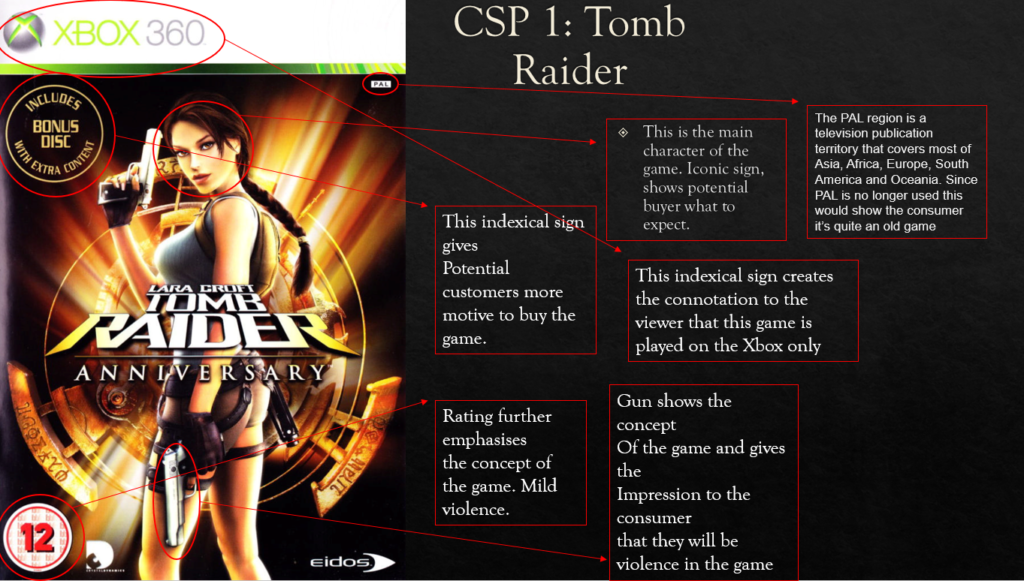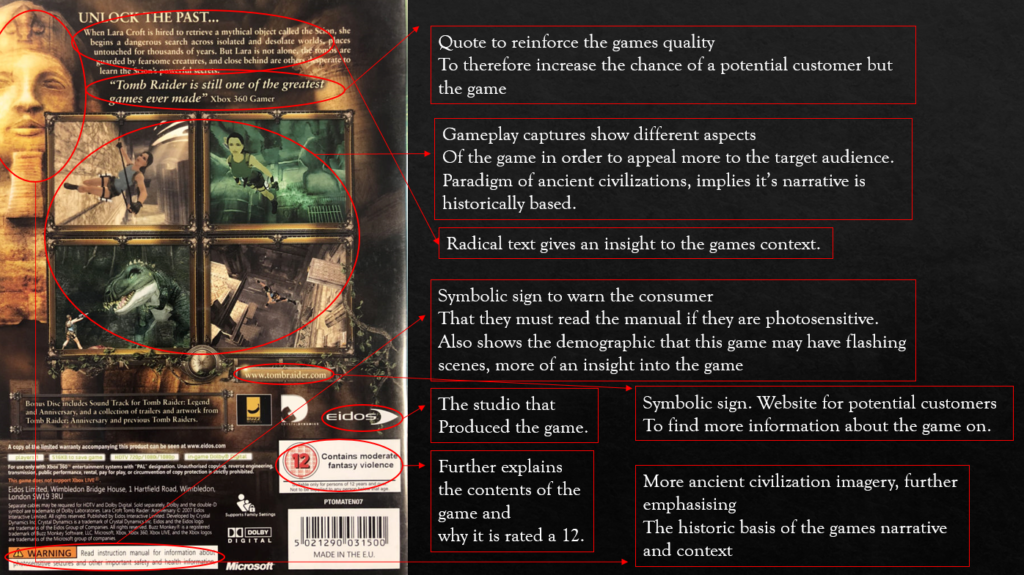







| Pose – subject positioning, stance or body language | Fourth Wall Breaks: where the subject meets gaze with audience – can be confrontational, aggressive, invitational etc… Off-Screen Gaze: upward can suggest spirituality; right-frame gaze can suggest adventure, optimism; left-frame gaze can suggest regret, nostalgia Body Language: open, closed, passive, active, strong, weak Subject positioning: positioning and angle of group shots illustrates the characters with more powerful/dominant role Proxemics: if subjects are positioned closer together, often shows close relationship |
| Mise en Scene – props, costume, setting | Prop Symbolism: props are rarely accidental, use and placement often have symbolic connotations Setting Symbolism (Pathetic Fallacy): settings and scenery are often symbolic of a characters emotions Costume Symbolism: stereotypes can be constructed through costume, helping us discover characters narrative function |
| Lighting | High-Key: lack of shadow, producing a lighter more upbeat tone Low-Key: emphasises shadow, producing a darker and serious tone Chiaroscuro: high contrast lighting eg light beams penetrating pitch black conveying hopelessness or misery Ambient: infers realism |
| Compositional Effects – distance, angle, positioning of subjects | Long Shot: implies subject is dominant of environment Closeup: intensifies character emotions or suggests impending drama Left Compositions: left of screen is generally reserved for characters whom the audience is to sympathise with Right Compositions: right screen usually reserved for unfavourable characters Open frame: suggests freedom Closed frame: suggests entrapment Tilt-up and High Eyeline: conveys power Tilt-down and Low Eyeline: conveys vulnerability |
| Post-Production Effects | Colour Control: often exaggerated for a specific connotative effect – red conveys anger; white conveys innocence; blue conveys sadness etc… High saturation: increased colour levels creates a cheery tone Desaturation: decreasing colour of an image creates a serious, sombre tone |
Sign – Stands in for something else.
Code – used to construct meaning in media forms
Convention– the accepted way of doing something.
Dominant signifier– the main thing that stands in for something else.
Anchorage– words that go along with an image to give meaning of context.
Ferdinand De Saussure – Swiss linguist, semiotician and philosopher. Ferdinand de Saussure: Saussure believed in a concept, that can be described as “the study of signs and symbols and their use or interpretation.” One of the two founders of semiotics, introduced these terms as the two main planes, these terms being the ‘signifier’ and the ‘signified’.
C S Pierce: Pierce believed that there were only 3 signs ever, Iconic, Indexical and symbolic. Furthermore this implies that everything is made up of these 3 signs.
Roland Barthes: Barthes semiotician work focused on the signs in the news and how to read them, he would take apart scenes in the news to analyse them more easily and find out what the news is actually saying.
paradign– a collection of similar signs
syntagm– the sequences in which signs work.
SEMIOTICS
sign- something which can stand for something else
code– written or symbolic tools used to suggest meaning in media forms.
convention- accepted ways of using media codes
dominant signifier- the main sign
anchorage- Words with an image to go along with the text which provides context
FERDINAND DE SAUSSURE
Signified-stands in for something else
signifier-thing or idea trying to be evoked
C S PIERCE
icon-a sign that looks like its object
index- a sign that has a link to its object
symbol-a sign that has a more random link to its object
ROLAND BARTHES
signification- structural levels of signification, meaning or representative
denotation-the most basic or literal meaning of a sign
connotation- signs that are used as signifiers for a secondary meaning
myth- naturalizes events, turning history into nature
ideology- codes that reinforce or are congruent with structures of power
radical- something that challenges dominant ideas
reactionary- something that confirms dominant ideas
Paradigm- a typical example or pattern of something; a pattern or model
Syntagm- a linguistic unit consisting of a set of linguistic forms (phonemes, words or phrases) that are in a sequential relationship to one another.
| Semiotics | |
| Sign | Something which can stand for something else |
| Code | Written or symbolic tools used to suggest meaning in media forms |
| Convention | Accepted ways of using media code |
| Dominant Signifier | The main representative |
| Anchorage | Words with an image to provide context |
| Ferdinand de Saussure | |
| Signifier | Stands in for something else |
| Signified | Idea being evoked by signifier |
| C S Pierce | |
| Icon | A sign that looks like its object |
| Index | A sign that has a link to its object |
| Symbol | A sign that has a more random link to its object |
| Roland Barthes | |
| Signification | Structural levels of signification, meaning or representation |
| Denotation | The most basic or literal meaning of a sign |
| Connotation | Signs that are used as signifiers for a secondary meaning |
| Myth | Naturalizes events, turning history into nature |
| Ideology | Codes that reinforce or are congruent with structures of power |
| Radical | Something that challenges dominant ideas |
| Reactionary | Something that confirms dominant ideas |
| Paradigm | A collection of similar signs |
| Syntagm | The sequence in which signs work |
2. Denotation- First level analysis (what a reader can see on the page)
3. Connotation- Meanings or associations we have with the image
4. Myth- Naturalises events turning history into nature
5. Ideology- A world view about how society should function
6. Radical- Out of the ordinary or something you wouldn’t expect
7. Reactionary- Follows stereotypes or something you expect
8. Syntagm – Where signs occur in sequence or parallel and operate together to create meaning
9. Paradigm – A paradigmatic relationship is one where an individual sign may be replaced by another.
| MEDIA FORMS | CHARACTERISTICS | EXAMPLE | |
| 1. | Newspaper | -Advertisements included – Small writing -On news about that day/previous day | The Guardian |
| 2. | Magazines | -Specific to readers niche -Layout and images much more aesthetically pleasing -Not too lengthy | Prima |
| 3. | Television | -Advertisements in between -Larger niche audience -Visual | The Great British Bake Off |
| 4. | Radio | -Variety of media forms: Music, News and more -Takes a lot to produce and present -Audio | BBC Radio 1 |
| 5. | Video Games | -Single and Multi player use -Visual use/entertainment -Usually includes a plot or storyline in order complete game | Dragon’s Lair, Space Invaders |
| 6. | Music Video | -Audio and Visual entertainment -Most times has a storyline to go along with the song -Can be solo or groups depending on the artist/director | Old Me- 5SOS, Can We Dance- The Vamps, Not Your Summer- The Academic |
| 7. | Films/Movies | -Creates profit and expensive to create -Takes a long time to put together -Can be seen in many places: Cinemas, and online streaming services such as Netflix and Amazon Prime | Enola Holmes, Paddington, Mamma Mia |
| 8. | Marketing/Advertising | -Commercial Reasons -Have to pay to advertise: more expensive the more places it will get seen (Tv ad breaks, Billboards) -Competitions | Shampoo, Children’s Toys, Smart Devices |
| 9. | Social Media | -Interactive -Great for communication -Good for businesses and advertising purposes | Instagram, Facebook, Snapchat |
C.S. Peirce – Peirce’s seminal work in the field was anchored in pragmatism and logic. He defined a sign as “something which stands to somebody for something,” and one of his major contributions to semiotics was the categorization of signs into three main types: (1) an icon, which resembles its referent (such as a road sign for falling rocks); (2) an index, which is associated with its referent (as smoke is a sign of fire); and (3) a symbol, which is related to its referent only by convention (as with words or traffic signals). Peirce also demonstrated that a sign can never have a definite meaning, for the meaning must be continuously qualified.
Ferdinand De Saussure – Swiss linguist, semiotician and philosopher. His ideas laid a foundation for many significant developments in both linguistics and semiotics in the 20th century.
Roland Barthes – French literary theorist, essayist, philosopher, critic, and semiotician. Barthes’ ideas explored a diverse range of fields and he influenced the development of many schools of theory, including structuralism, semiotics, social theory, design theory, anthropology and post-structuralism.